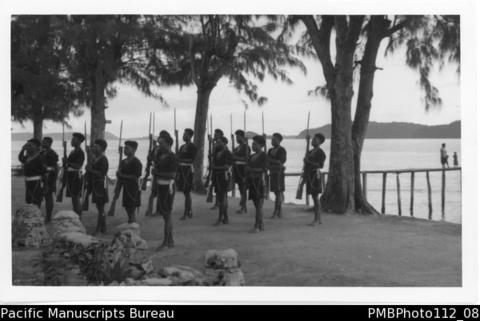Área de identidad
Código de referencia
AU PMB PHOTO 112-08
Título
Fecha(s)
- Dec 1949-Mar 1950 (Creación)
Nivel de descripción
Unidad documental simple
Volumen y soporte
1 digitised photograph
Área de contexto
Nombre del productor
Historia biográfica
Frank Menzies Cameron Forster was born in Sydney, NSW, on 21 September 1923. He moved to Melbourne with his mother, Jean Catherine Forster, a psychology graduate and later pioneering remedial teacher, and attended Princes Hill Primary School then Melbourne Grammar. In 1940 Frank went to the University of Melbourne to study medicine. While there, he underwent surgery for a tumour on his spine which left him with “spinal weakness and intermittent pain.” He graduated with a Bachelor of Medicine, Bachelor of Surgery (MBBS) in 1948 with honours in surgery, obstetrics and gynaecology.
At the end of the following year, Frank spent the four months December 1949-March 1950 in the Australian Territory of Papua and New Guinea. Post World War 2, Australian health and medical professionals went to work there, but Frank did not stay there or return later as far as is known. He did keep a small collection of black and white photographs he took at the time which show that he visited Samarai, Lae, Goroka, Madang and Manus, travelling by boat and plane.
By 1951 he was a resident doctor at the Royal Women’s Hospital (RWH) in Melbourne. In 1952 he married Prudence Isobel Swan Edgar, a nurse, and in 1953 they travelled together to London where Forster worked at the Hospital for Women and gained membership of the Royal College of Obstetricians and Gynaecologists.
The Forsters returned by 1954 to Melbourne where Frank worked again at the RWH. He became known for his bedside teaching and lively lectures, emphasising the need for care of pregnant women, and became a specialist in dealing with difficult pregnancies. In 1967, he gave the inaugural annual Tracy Maund Memorial lecture, honouring the memory of the two founders of the RWH. Not only was Frank Forster a practitioner with a flair for teaching and public speaking, he was also a collector of medical books, pamphlets and instruments, a researcher, archivist and writer of works related to medical matters, and an active member and financial supporter of several organisations such as the Medical History Museum and the medical professional body known as the Royal Australian College of Gynaecologists (RACOG) and later as RANZCOG when the Australian and New Zealand bodies amalgamated. Frank donated to RACOG’s library his collections of items relating to women’s health in 1987. The College renamed their library the Frank Forster Library in his honour when Frank died on 18 March 1995 age 71. Frank was survived by his wife, a daughter and three sons.
More information about Frank Forster is online at http://adb.anu.edu.au/biography/forster-frank-menzies-23427. See also the article “A College Benefactor: Frank Forster” in Australian and New Zealand Journal of Obstetrics and Gynaecology 2004; 44: 3-5.)
Institución archivística
Historia archivística
Origen del ingreso o transferencia
Área de contenido y estructura
Alcance y contenido
Valorización, destrucción y programación
Acumulaciones
Sistema de arreglo
Área de condiciones de acceso y uso
Condiciones de acceso
Available for reference
Idioma del material
Escritura del material
Notas sobre las lenguas y escrituras
Características físicas y requisitos técnicos
Instrumentos de descripción
Área de materiales relacionados
Existencia y localización de originales
Existencia y localización de copias
Access this title at PMB Member Libraries or by contacting the Bureau directly: http://asiapacific.anu.edu.au/pambu/accessing.php
Unidades de descripción relacionadas
Área de notas
Notas
Individual item titles are taken from supplied captions. The language is reflective of the period of captioning. Information added by cataloguer is included in square brackets [ ].
Identificador/es alternativo(os)
Puntos de acceso
Puntos de acceso por materia
Puntos de acceso por lugar
Puntos de acceso por autoridad
- Forster, Frank (Materia)
Tipo de puntos de acceso
Área de control de la descripción
Identificador de la descripción
Identificador de la institución
Reglas y/o convenciones usadas
Fechas de creación revisión eliminación
Idioma(s)
Escritura(s)
Fuentes
Objeto digital metadatos
Nombre del archivo
PMBPhoto112_08.jpg
Latitude
Longitude
Tipo de soporte
Imagen
Mime-type
image/jpeg
